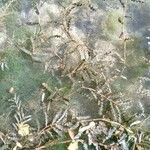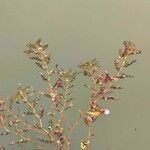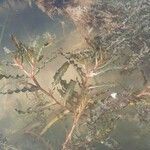Rhizomes absent. Cauline stems flattened, without spots, to 100 cm; nodal glands absent. Turions common, axillary or terminal, 1.5--3 ´ ca. 2 cm, hard; leaves ± 2-ranked; outer leaves 1--4 per side, base not corrugate, apex rounded; inner leaves rolled into linear, terete structure, oriented parallel to outer leaves. Leaves submersed, ± spirally arranged, sessile, lax; stipules persistent to deliquescent, inconspicuous, convolute, free from blade, brownish, not ligulate, to 0.5 cm, not fibrous, not shredding at tip, apex obtuse; blade light to dark green, linear, not arcuate, 1.2--9 cm ´ 4--10 mm, base obtuse to rounded, without basal lobes, not clasping to nearly clasping, margins conspicuously serrate, not crispate, apex not hoodlike, round to round-acute, lacunae in 2--5 rows each side of midrib; veins 3--5. Inflorescences unbranched, emersed; peduncles not dimorphic, terminal or rarely axillary, erect to ascending, cylindric, 2.5--4 cm; spikes not dimorphic, cylindric, 10--15 mm. Fruits sessile, red to reddish brown, obovoid, turgid to slightly concave, not abaxially or laterally keeled, 6 ´ 2.5 mm; beak apically recurved, 2--3 mm; sides without basal tubercles; embryo with 1 full spiral. 2n = 52 (Europe).
Vertical shoots short-lived, seasonal; stems filiform to slender, compressed, subquadrangular, to 1 m long, mostly sparsely branched, producing specialised non-dormant axillary turions; horizontal shoots short but strongly branched. Floating leaves absent; submerged leaves linear to broadly linear-ovate, sessile, sometimes slightly clasping, lamina 40-70(-90) by 4-8(-15) mm, 3-veined, margin serrate and often undulate, base obtuse, apex rounded to obtuse; stipules axillary, convolute, 9-15 mm, thinly membranous. Spikes suborbicular to cylindrical, contiguous or shortly remote, 10-15 mm; peduncle 20-50 mm, not thickened. Flowers 5-8, with 4 carpels. Fruits broadly ovate, 4-6 mm, adnate at base, obscurely toothed on the median ridge of the back, beak elongate, c. 2 mm. Stem anatomy: Stele of oblong type. Endodermis of O-type. Interlacunar bundles and subepidermal bundles absent. Pseudo-hypodermis present, 1-layered. Chromosome number 2n = 52.
Plants perennial, submerged in fresh water. Rhizome present, terete to slightly flattened. Stems creeping at base, terete to slightly flattened and angular, sparsely branched; stiff axillary turions 1-3 cm × 8-15 mm, each a cluster of hard scales formed by strongly shortened, thickened and broadened leaves. Stipules axillary, convolute to shortly connate, 5-10 mm, membranous and evanescent; leaves sessile, broadly linear to narrowly oblong, 3-8 cm × 3-10 mm, 3-7-veined, margin mostly undulate or crispate, serrate, apex obtuse or rounded. Spikes cylindric, with 2-4 whorls of shortly distant opposite flowers; peduncles 14-65(-125) cm. Carpels 4, shortly connate at base. Fruit ovoid, 3.5-4 mm, abaxial keel distinct, few toothed on lower ridge; beak subequal to or longer than body of carpel, slender. Fl. and fr. Apr-Jul. 2n = 52.
Fairly large plants 50-150 cm high, with much ramified perennating rhizomes which also form horny winterbuds. Stems slender, 4-angled, branched above. Leaves all submerged, sessile, linear-lanceolate, 3-9 cm long and 8-15 mm broad, apex obtuse, apiculate, margin finely serrate, markedly undulate, often reddish, shiny translucent, longitudinal veins 3-5, the laterals close to the margin; stipular sheath convolute, 10-20 mm, sub-triangular, obtuse, early deciduous. Spikes few-flowered, somewhat lax, peduncle 2.5-7 cm long, slender, narrowed upwards, usually curved; flowers 5-10. Drupe 2-4 mm long, ovoid-acuminate, laterally compressed, with a prominent pectinate dorsal keel, the ventral keel fairly straight, beak nearly as long as the fruit, falcate, tapered.
Stems compressed, 3–8 dm, sparingly branched; rhizomes elongate and slender; lvs all submersed, linear-oblong, 3–8 cm × 5–12 mm, rounded or obtuse to minutely cuspidate, finely and irregularly toothed and rather crisply undulate-margined, narrowed or rounded to a sessile base, 3–5-veined; stipular sheaths 3–8 mm, adnate at base to the lf, scarious, soon disintegrating; hard winter-buds commonly produced; peduncles 2–5 cm, often recurved in fr; spike dense, 1–2 cm; body of the achene ovoid, 3 mm, shallowly pitted, with 3 round dorsal keels, the central one prolonged at base into a projecting appendage; achene-beak erect, conic, 2–2.5 mm; 2n=52. Native of Europe, locally intr. in alkaline or high-nutrient waters nearly throughout our range.
Entirely submersed; rhizomatous. Stems to 180 cm long, much-branched, ± 4-angled. Leaves sessile, c. 1.5-6-(8) cm × 4-8-(12) mm, linear-oblong, obtuse, conspicuous nerves 3, widely spaced, usually with 2 finer submarginal nerves, margins ± crimped, usually with minute teeth especially towards tip, translucent, occasionally reddish; stipules 3-5 mm long, membranous, delicate and soon deteriorating to fibres. Peduncles 3-5 cm long, terete, often recurved. Spikes 0.5-1 cm long, few-flowered. Achenes to 4 mm long, including prominent curved beak ± = body, dark olive, flattened on sides, keel ± denticulate, lateral angles obscure.
Submerged, aquatic annual herb. Stem compressed, several metres long; turions common, hard, almost sclerenchymatous. Stipules forming funnel-shaped truncate sheath to 5 mm long, often disintegrating. Leaves sessile, narrow to broadly lanceolate, 2–6 cm long, 0.5–1 cm wide, acute at base, serrulate for most of blade, obtuse, rarely acute, 3–5-veined; lacunae present on both sides of midrib. Inflorescence terminal or axillary, a capitulate or shortly cylindric spike. Peduncles erect, rarely recurved. Fruit abaxially rounded, laterally compressed, 2.5–3.5 mm long (including beak), with 3 crenulate dorsal keels.
Perennial herb, hydrophyte, height depending on depth of water, with ramified rhizomes; stem slender, 4-angled. Leaves all submerged, sessile, linear-lanceolate, 30-90 x 80-150 mm; apices obtuse, apiculate, margins finely serrate, undulate, often reddish. Peduncle 25-70 mm long, slender, narrowed upwards, usually curved. Inflorescence a few-flowered spike. Flowering time Nov.-? Fruit a 2-4 mm long drupe, ovoid-acuminate, laterally compressed; dorsal keel pectinate; ventral keel ± straight; beak as long as fruit, falcate, tapered.
A herb which grows under water. It extends about 2-8 m across. It has underground stems or rhizomes. There are also trailing stems which are flattened and 4 m long. The leaves are alternate. The leaves are 2.5-10 cm long by 0.5-1.5 cm wide. They are narrowly oblong. They do not have a stalk. They are thin and deep green. The edges have fine teeth and are wavy. The flower spikes are 0.8-2 cm long.
Perennial herb. Leaves submerged; blades uniform narrowly linear-ovate, margins clearly toothed, markedly undulate. Flowers: spikes few-flowered; Oct.-Dec. Fruit 2-4 mm long.
Perennial herb, up to 1.5 m high. Leaves all submerged, uniform, wider than 4 mm, leaf margin toothed and undulate. Spikes few-flowered. Beak nearly as long as fruit.




